#the school of technology and engineering
Explore tagged Tumblr posts
Text

Workshops of the School of Technology and Engineering in Cluny, Burgundy region of France
French vintage postcard
#engineering#postal#school#region#the school of technology and engineering#vintage#postkaart#ansichtskarte#photo#cluny#burgundy#tarjeta#ephemera#french#technology#sepia#postkarte#france#carte postale#briefkaart#workshops#photography#postcard#historic
8 notes
·
View notes
Text



36/100 Good morning beautiful people!!
I am becoming a better version of myself every single day. I handle challenges with calm and clarity. My potential is limitless. I am worthy of love, success, and happiness. I radiate confidence, self-respect, and inner harmony. I let go of what I can’t control and focus on what I can. I am exactly where I need to be right now.
log: 9/5/25
Walk morning and afternoon
Deep Clean and Laundry
mental health check __journal
Read 50 pages
Study session 3P
Proper lunch and dinner
DD_30 challenge: Day 6
#stem academia#studyblr#women in stem#100 days of productivity#study space#study motivation#study blog#studyspo#realistic studyblr#chaotic academia#reading#stemblog#programming#stem student#stemblr#engineering college#engineering#engineering student#technology#grad school#gradblr
78 notes
·
View notes
Text
Earth 🌎 🌍
#Diameter : 7926 miles ( 12,756 km )
#Mass : 5976 million million million tons
#Temperature : -70 to 55°C
#Distance from Sun : 93 million miles ( 150 million Km )
#Length of day : 23.92 earth days
#Length of year : 365.25 earth days
#Surface Gravity : 1 kg = 1 kg
#earth
#photochallenge #everyoneシ゚ #SpaceScienceBangladesh #science #knowledge #spacescience #astronomy #education #physics #Educational #sun #earth #astrology #astronaut #astrophysics #NASA #uk #spaceexploration #university #college #school #spaceshuttle #astrophotography
#solarpower #solarenergy #energy #spacewalk





#science#writing#photography#positivity#quotes#nature#illustration#museums#home & lifestyle#school#collage#university#astronomy#astrology#astro community#astrophysics#physics#mathematics#space#spacescience#technology#knowledge#books#nasa#europe#engineering#usa#machinelearning#rocket science#nuclear
9 notes
·
View notes
Text
Applying for my Master's in gender studies kind of feels like shooting myself in the foot, but then again, it's not a useless discipline if it's being systematically censored and erased.
#not sure what research i could offer that has actual value#like i'm not doing scientific or health-related research. i'm not an engineer like all my relatives lol#i just like to think... and theorize..... what happened to all the theorists and philosophers?#seems like nowadays there's no point to grad school unless you're doing something stem or business related#annoying as fuck really.#i thought very hard about information technology and there's still time. i just have such a passion for gender/queer studies#too bad there aren't any programs that are just focused on queer/trans studies :)))))#and gender studies programs are at risk of being shut down. so that's awesome.#i still have some thinking to do....... because i don't want to shoot myself in the foot#like do i really want to work in higher education? do i reeeeally?#at the risk of sounding very arrogant i will say i'm not worried about my application if and when i do it#because i was easily the top student in my undergrad program and i have my current job to show for it#i've got great references and writing samples. just need a more concise idea for a research project...
13 notes
·
View notes
Text
im glad we’re finally talking about lack of technology literacy in younger people. everyone assumes we’ll automatically be good at it and have all the know-how because we grew up with it, and sure i might be more knowledgeable about it than say, someone 15 years older, but technology is changing and becoming more “turnkey” and a lot of the customization and workarounds just are not that accessible or obvious anymore. several tech companies boast that their new products are so simple and easy that a baby could do it, and users no longer have to figure out or understand anything behind the scenes because look, there’s a button right there you can press for this issue and if you’re still having problems you can just take it to a technician.
and im not saying this is inherently bad, it’s more accessible to people who don’t know anything about technology, but we are losing our computer skills because we don’t understand the tech and don’t see a need to. you buy a phone or a laptop and it’s perfectly usable fresh out the box and you don’t have to do anything to customize it because they’ve done it for you, which sucks especially considering they often don’t even want you to mess with the programming or software. customization is discouraged so they give you a handful of options they picked out and that’s that, and if your computer goes kaput then instead of learning how to fix it you can just throw it away and buy a new one! and while turnkey tech is a good option for a lot of people, we should still be encouraging know-how and teaching tech literacy in school as we become even more dependent on it. so many young people are struggling to work on computers and no one thinks to teach them because of the generation they’re in. it’s a major issue.
#like i know so little about programming software and engineering and i’ve tried to get into it but im not a kid anymore and my brain isn’t#nearly as malleable as it used to be#and so the concepts come a lot harder to me than they would have in grade school#the furthest extent my official computer education went was making mother’s day cards in photoshop and ms paint#so#text post#technology literacy
129 notes
·
View notes
Note
I have a headcanon that norway is actually really good at speaking (eu) spanish as spanish is the most popular language norwegians choose to learn in high school (with german being the next most popular, he's probably fluent in that too lmao) what am saying is; norway could probably hold a conversation with Spain without any problem🇪🇸🗣️
(also let's be real, norway would probably need to speak/understand spanish as spain is his hollyday paradise😂)
Come on, you don't need to know Spanish to go on holiday there?? We know there's only one phrase you'd need to know how to say when in Spain 😎 /j
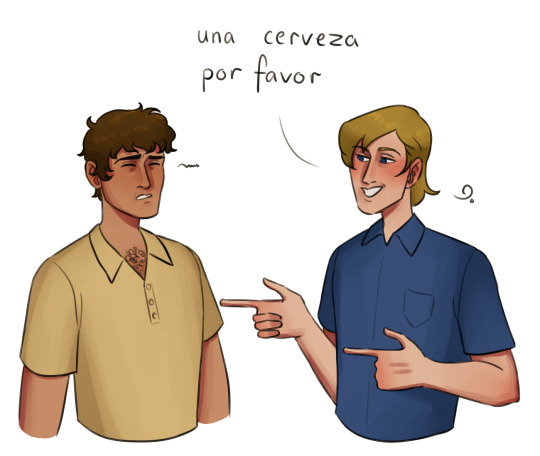
#hetalia#aph norway#aph spain#hws norway#hws spain#lol but you are prob very correct tho!#I had spanish in school too! And super popular tourist destination ofc#tho there are a lot of retired norwegians living there and just refusing to learn the language too 🙈 and importing norwegian foods#and german is just a language Norway prob had to learn ages ago with all the trading with the Hansaetatene#and with all the technology and engineering the germans brought to norway during the later centuries too#german is unavoidable as a language for norway
50 notes
·
View notes
Text
How to get into Coding!
Coding is very important now and in the future. Technology relies on coding and in the future you will need to know how to code to get a high-paying job. Many people consider having Computer Science field-related jobs, especially in AI. What if you are interested it in general or as a hobby? What if you don't know what you want to do yet for college?
Pick a language you want to learn: Personally, I started out with HTML and CSS. I recommend if you want to do web design HTML and CSS are good languages to start with. Otherwise, start with JavaScript or Python.
2. Find Resources: Basically you want to look at videos on YouTube, and take classes that have coding like AP CSP, AP CS A (harder class), Digital Information Technology, etc. You can also attend classes outside in the summer like CodeNinjas and use websites like code.org, freeCodeCamp, and Codecademy. Also, ask your friends for help too! You can find communities on Reddit and Discord as well.
3. Start Practicing: Practice slowly by doing small projects like making games for websites and apps. You can work with friends if you are still a beginner or need help. There's also open-source coding you can do!
4. Continue coding: If you don't continue, you will lose your skills. Be sure to always look up news on coding and different coding languages.
5. Certifications: If you are advanced in coding or want to learn more about technology, you can do certifications. This can cost a lot of money depending on what certification you are doing. Some school districts pay for your certification test. But if you take the test and pass, you can put it on your resume, and job recruiters/interviewers will be impressed! This can help with college applications and show initiative if you want a computer science degree. This shows you are a "master" of the language.
#tech#coding#learning#education#hobby#fun#jobs#high school#college#university#youtube#reddit#certification#javascript#java#python#html css#css#html#ap classes#ap csp#information technology#technology#computer science#programming#software engineering#web design#web development#discord chat#discord server
10 notes
·
View notes
Text
Had a moment of listening to music I liked back when I was a teenager (& still like) and having a whole. Realization . That I like myself as I am now sooooo much better than I like teenage me. And I started thinking about Why.
There's a lot to it I'm pretty sure, & most of it centers around the fact that I just... didn't really know who I was as a person. I didn't really have hobbies outside of what I did in school (aka orchestra) and like. Video games + anime. I did creative writing in middle school, but dropped off in high school for... some reason? I still made original characters and played around with them a lot, but it was mostly just in drawing and thinking about them. I never actually *wrote*, and I in fact didn't get back into creative writing at all until I was 23 years old. I was someone who had spent so long hiding behind others and just doing what I was told that I just... didn't have any real direction. I didn't know what I even *wanted*. I thought I knew, but in hindsight, I can confidently say that I didn't. I was just an insecure teen drifting through life and not thinking about things beyond what was immediately in front of me. Which is pretty standard for teenagers I guess, but not all of them. Not at all.
Compared to now, where I have Many hobbies, most notably being writing. As I am now, I am just Intrinsically a writer. And it's weird to remember that I wasn't even really *writing* before 5 years ago (besides text rps, which did a lot for developing my writing skill! But still aren't a replacement for writing individually). As a teen, I wasnt into dnd, I was incredibly out of shape, & I was a lot less aggressive and focused. I was the type to avoid sports!!! I hated them!!!! But as I am now, I Love biking and can easily bike for an hour+ no problem (I remember being a teen and trying to go on just 10 minute bike rides in the summer and just *dying* from it), & I love working out. I wanna be strong!!! I LOVE being strong!!! And I was an absolute mess with things like public speaking & working in groups, vs now where I can do an impromptu presentation no problem & I'm often the unofficial leader in group projects bc im typically the one who does the organizing and allotments of work. A side effect of working as a supervisor and then assistant manager for so long. I have a lot more confidence in my perceptions and judgements, & I have the self-assurance to assert these things. And this is only really the tip of the iceberg with all the differences.
I just feel like an entirely different person, almost. The cores are the same, or at least damn near similar, with the things I want out of life & the sorts of things I enjoy, but it's like. The difference between finding a random rock off the side of the road & then that rock when it's been sanded and carved and decorated to be something individual and unique. You look at them side by side and it's something dull vs something shiny and intricate. The origins can't be ignored and dismissed, & I certainly would never resent younger me for just doing the best with what I knew at the time. But it's just astounding how much difference time and experience will have for growing and developing as a person. Things I consider integral to my personhood weren't even thoughts in my mind back then. We are almost entirely different people.
#speculation nation#under readmore bc I just got contemplative. not negative really either.#ultimately it's that kind of thing of like. college & all my experiences within it have done a LOT for developing who i am as a person.#i wouldnt be nearly so comfortable with public speaking if it werent for how many speech classes ive taken over the years.#but it's also the fact that i was working to figure out who i was during college that made me fumble it so hard.#i wanted to be an engineer. can you believe it? i was so CERTAIN of it as a teenager. but it was only really bc of the family i have/had#that are/were engineers. i didnt have personal interest in it. it was just the Thing To Do.#so i got to college and i *hated* it and i had to take several years to figure out what i actually Wanted.#i realized pretty quickly that i wanted to focus on computers after my first coding class. but thats so BROAD#and computer science wasnt for me either. i fucking hated computer science. but computer information & technology??#this is my shit. and honestly it's so weird to remember that just 10 years i knew very little about computers#and now ill be sitting in my web programming class & theyre talking about javascript and loops and such within it#and im just zoning tf out bc Yeah Yeah do while loops ive heard it a million times before. arrays?? yeah whatever i got it#but back in 2016 i had to learn these things for the first time!!! it was entirely new to me!!! teenage me didnt KNOW#so me being a computer person with a specialization in business and hobbies of writing and biking and dnd. i had NONE of those things!!!#i didnt even collect knives!!!!! granted thats mostly bc i Couldnt buy many of them yet + i also didnt have much money lol#bc i never even worked a job until i got to college. that's also unimaginable to me. imagine not knowing what it's like to Work...#i remember getting $500 or so in graduation gifts after graduating high school & my mind was just Blown#had never had that much money before. it was crazy to me. meanwhile with a job paying every other week $500 was a *low* paycheck.#but i also have to pay bills and rent and buy food and all this stuff. also things i didnt have to worry about back then. ALSO weird.#idk theres a lotta bullshit i gotta deal with as an adult but i like who i am now so much better. feel so much more *myself*#than just a directionless teenager waiting for someone to tell them what to do.#it's amazing what 10 years will do for your development as a person. absolutely wild.
2 notes
·
View notes
Text











As a high school science teacher, I can’t wait to dive into this LEGO Ideas collectible display model on The Evolution of STEM! 🔬🧬🍎
The 879-piece set features a buildable base in the shape of an open book topped by mini builds that represent historic innovations – from an early car and a home computer to the NASA Voyager Probe. Turning a dial also adds a fun movable element to the mix, making a 3D replica of a carbon atom float upwards and a DNA strand rotate. Also included are minifigures of 3 famous scientists: Marie Curie (the “Mother of Modern Physics”), Sir Isaac Newton (leader of the Scientific Revolution), and George Washington Carver (a pioneering agricultural scientist). All in all, it’s a perfect set to add to my classroom!
#collecting#collector#collectibles#collection#lego#legos#lego sets#lego ideas#stem#stem academia#stem toys#stemblr#science#technology#engineering#math#mathematics#marie curie#isaac newton#george washington carver#minifigures#lego minifigures#nasa#dna#evolution#high school teacher#high school#teacher#science teacher#physics
3 notes
·
View notes
Text
Electronics Components #components #electronics #engineering #electrical #arduino #electronic #innovation #design #robotics #electroniccomponents #raspberry #technology #manufacturing #industrial #gaming #school #learningbydoing #solar #bahrain #pc #pcb #budaiya #muhharaq #manama #engineeringforkids #saar #riffa #makersgonnamake #isatown #summerprogram
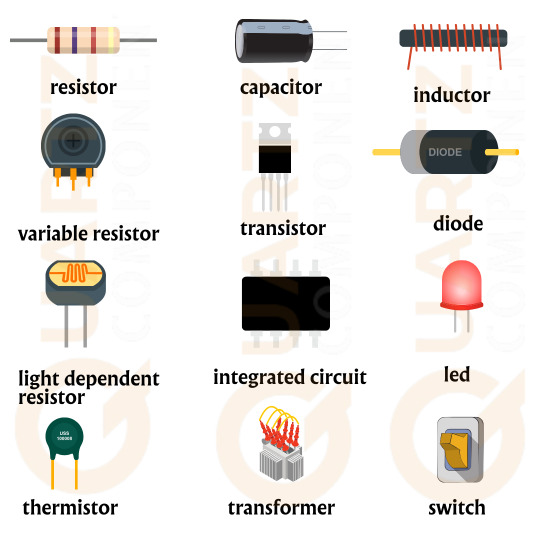
#Electronics Components#components#electronics#engineering#electrical#arduino#electronic#innovation#design#robotics#electroniccomponents#raspberry#technology#manufacturing#industrial#gaming#school#learningbydoing#solar#bahrain#pc#pcb#budaiya#muhharaq#manama#engineeringforkids#saar#riffa#makersgonnamake#isatown
13 notes
·
View notes
Text

Our Sound Engineering Training in Quebec is designed to equip aspiring sound engineers with the skills and knowledge needed to succeed in the audio industry. This comprehensive training covers all aspects of sound engineering, including recording techniques, mixing, mastering, acoustics, sound design, and live sound. Whether you're interested in music production, sound for film, or live events, our Sound Engineering Training in Quebec offers hands-on experience with industry-standard equipment. Learn from experienced instructors in one of the most dynamic creative centers and kickstart your career in sound engineering.
#sound engineering training in Quebec#sound engineering courses Quebec#audio engineering training Quebec#audio production Quebec#sound engineering programs#recording techniques#mixing and mastering#acoustics#sound design#live sound training#music production training#professional sound training#audio engineering school Quebec#sound engineer certification Quebec#audio technology courses
2 notes
·
View notes
Text

Interior of the School of Technology and Engineering in Cluny, Burgundy region of France
French vintage postcard
#postcard#school#ansichtskarte#briefkaart#france#interior#photography#carte postale#vintage#postkarte#photo#historic#postkaart#ephemera#technology#sepia#the school of technology and engineering#cluny#engineering#burgundy#region#french#tarjeta#postal
8 notes
·
View notes
Text
The Nation’s Only High School Integrating Cyber Technology & Engineering Into All Academic Disciplines
A publicly funded commuter and residential 9-12 magnet school serving students from around the state, offering free tuition for a diverse student body that is about 30% African American and 37% female.
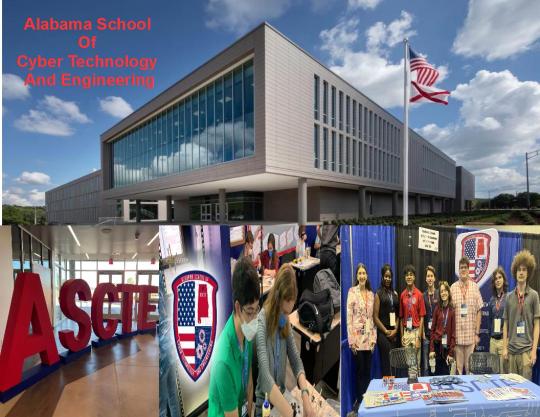
View On WordPress
2 notes
·
View notes
Text
Jupiter Planet
#Diameter : 88,846 miles ( 142,984 km )
#Mass : 1,900,000 million million million tons
#Temperature : -153°C ( extrêmes not available )
#Distance from Sun : 483 million miles ( 778 million Km )
#Length of day : 9.84 hours
#Length of year : 11.86 earth years
#Surface Gravity : 1 kg = 2.53 kg
#Jupiter
#photochallenge #everyoneシ゚ #SpaceScienceBangladesh #science #knowledge #spacescience #astronomy #education #physics #Educational #sun #earth #astrology #astronaut #astrophysics #NASA #uk #spaceexploration #university #college #school #spaceshuttle #astrophotography
#solarpower #solarenergy #energy #spacewalk


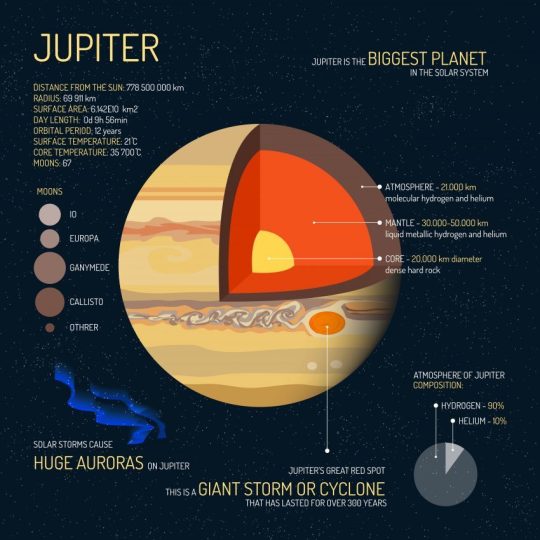



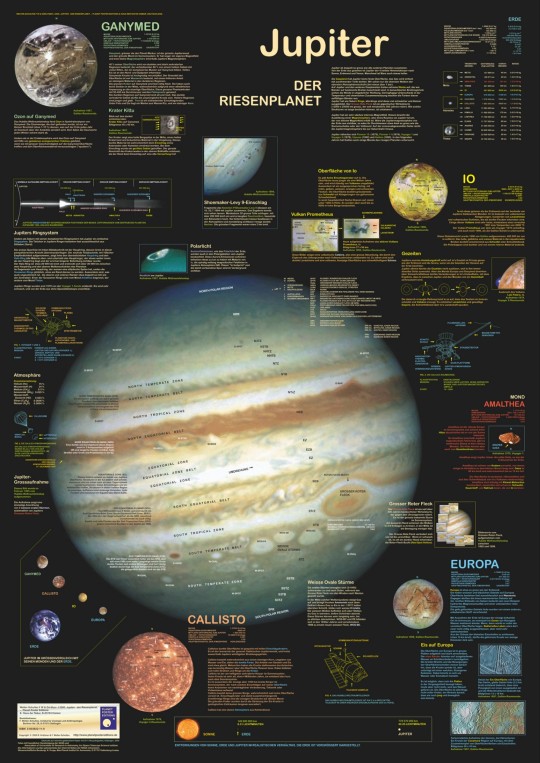
#science#photography#writing#quotes#positivity#nature#museums#illustration#engineering#education#spacescience#space#school#collage#university#united states#nasa#nasa photos#physics#mathematics#knowledge#instagram#information#technology#books#astrophysics#astro community#astrology#astronomy#words
8 notes
·
View notes
Text

love these tags but smart printer need to die. my empathy ends with them

stumbled across some of my printer opinions that i don't recall writing but am correct about
#I don't want all my devices to connect to the Internet!!!#i had an english teacher in high school who was obsessed with smart technology#and she'd make us write essays on our opinions of the great future ahead of us with smart tech#and every time i refused to suck smart techs dick in my essays#and she would argue with me about how it would be “so great to have the fridge just order your stuff for you!”#because like “that way you dont need to think abt what to eat” ;; excuse me what#i would say like#i dont really fancy my fridge deciding that for me. and not seeing my options in the store. and it just auto billing it or smth#and she just refused to understand what i did not like about my fridge potentially connecting to megacorps running search engines#will never forget that woman. she always gave me the side eye because i used curse words in my smart tech essays but couldnt stop me#i dont miss high school for a second. but this is permanently etched into my brain because it was so funny to me
91K notes
·
View notes
Text
Window-Sized Device Taps The Air For Safe Drinking Water
Massachusetts Institute of Technology (MIT) Engineers Developed An Atmospheric Water Harvester That Produces Fresh Water Anywhere — Even Death Valley, California.
— Jennifer Chu | MIT News | Date: June 11, 2025

A close-up of a new origami-inspired hydrogel material, designed by MIT Engineers, that swells to absorb water from the air. When water condenses out of the material to be collected, the individual hydrogel spheres shrink back down to capture more moisture. Credit: Courtesy of the Researchers
Today, 2.2 billion people in the world lack access to safe drinking water. In the United States, more than 46 million people experience water insecurity, living with either no running water or water that is unsafe to drink. The increasing need for drinking water is stretching traditional resources such as rivers, lakes, and reservoirs.
To improve access to safe and affordable drinking water, MIT engineers are tapping into an unconventional source: the air. The Earth’s atmosphere contains millions of billions of gallons of water in the form of vapor. If this vapor can be efficiently captured and condensed, it could supply clean drinking water in places where traditional water resources are inaccessible.
With that goal in mind, the MIT team has developed and tested a new atmospheric water harvester and shown that it efficiently captures water vapor and produces safe drinking water across a range of relative humidities, including dry desert air.
The new device is a black, window-sized vertical panel, made from a water-absorbent hydrogel material, enclosed in a glass chamber coated with a cooling layer. The hydrogel resembles black bubble wrap, with small dome-shaped structures that swell when the hydrogel soaks up water vapor. When the captured vapor evaporates, the domes shrink back down in an origami-like transformation. The evaporated vapor then condenses on the the glass, where it can flow down and out through a tube, as clean and drinkable water.
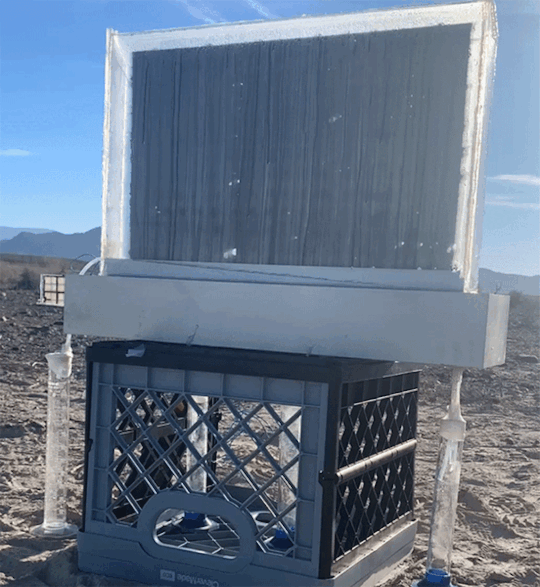
MIT Engineers test a passive water harvester in Death Valley, California. The window-sized setup is made from an origami-inspired hydrogel material (black) that absorbs water from the air, and releases it into tubes where researchers can collect the moisture as pure drinking water. Credit: Courtesy of the Researchers; MIT News
The system runs entirely on its own, without a power source, unlike other designs that require batteries, solar panels, or electricity from the grid. The team ran the device for over a week in Death Valley, California — the driest region in North America. Even in very low-humidity conditions, the device squeezed drinking water from the air at rates of up to 160 milliliters (about two-thirds of a cup) per day.
The team estimates that multiple vertical panels, set up in a small array, could passively supply a household with drinking water, even in arid desert environments. What’s more, the system’s water production should increase with humidity, supplying drinking water in temperate and tropical climates.
“We have built a meter-scale device that we hope to deploy in resource-limited regions, where even a solar cell is not very accessible,” says Xuanhe Zhao, the Uncas and Helen Whitaker Professor of Mechanical Engineering and Civil and Environmental Engineering at MIT. “It’s a test of feasibility in scaling up this water harvesting technology. Now people can build it even larger, or make it into parallel panels, to supply drinking water to people and achieve real impact.”
Zhao and his colleagues present the details of the new water harvesting design in a paper appearing today in the journal Nature Water. The study’s lead author is former MIT postdoc “Will” Chang Liu, who is currently an assistant professor at the National University of Singapore (NUS). MIT co-authors include Xiao-Yun Yan, Shucong Li, and Bolei Deng, along with collaborators from multiple other institutions.
Carrying Capacity
Hydrogels are soft, porous materials that are made mainly from water and a microscopic network of interconnecting polymer fibers. Zhao’s group at MIT has primarily explored the use of hydrogels in biomedical applications, including adhesive coatings for medical implants, soft and flexible electrodes, and noninvasive imaging stickers.
“Through our work with soft materials, one property we know very well is the way hydrogel is very good at absorbing water from air,” Zhao says.
Researchers are exploring a number of ways to harvest water vapor for drinking water. Among the most efficient so far are devices made from metal-organic frameworks, or MOFs — ultra-porous materials that have also been shown to capture water from dry desert air. But the MOFs do not swell or stretch when absorbing water, and are limited in vapor-carrying capacity.
Water From Air
The group’s new hydrogel-based water harvester addresses another key problem in similar designs. Other groups have designed water harvesters out of micro- or nano-porous hydrogels. But the water produced from these designs can be salty, requiring additional filtering. Salt is a naturally absorbent material, and researchers embed salts — typically, lithium chloride — in hydrogel to increase the material’s water absorption. The drawback, however, is that this salt can leak out with the water when it is eventually collected.
The team’s new design significantly limits salt leakage. Within the hydrogel itself, they included an extra ingredient: glycerol, a liquid compound that naturally stabilizes salt, keeping it within the gel rather than letting it crystallize and leak out with the water. The hydrogel itself has a microstructure that lacks nanoscale pores, which further prevents salt from escaping the material. The salt levels in the water they collected were below the standard threshold for safe drinking water, and significantly below the levels produced by many other hydrogel-based designs.
In addition to tuning the hydrogel’s composition, the researchers made improvements to its form. Rather than keeping the gel as a flat sheet, they molded it into a pattern of small domes resembling bubble wrap, that act to increase the gel’s surface area, along with the amount of water vapor it can absorb.
The researchers fabricated a half-square-meter of hydrogel and encased the material in a window-like glass chamber. They coated the exterior of the chamber with a special polymer film, which helps to cool the glass and stimulates any water vapor in the hydrogel to evaporate and condense onto the glass. They installed a simple tubing system to collect the water as it flows down the glass.
In November 2023, the team traveled to Death Valley, California, and set up the device as a vertical panel. Over seven days, they took measurements as the hydrogel absorbed water vapor during the night (the time of day when water vapor in the desert is highest). In the daytime, with help from the sun, the harvested water evaporated out from the hydrogel and condensed onto the glass.
Over this period, the device worked across a range of humidities, from 21 to 88 percent, and produced between 57 and 161.5 milliliters of drinking water per day. Even in the driest conditions, the device harvested more water than other passive and some actively powered designs.
“This is just a proof-of-concept design, and there are a lot of things we can optimize,” Liu says. “For instance, we could have a multipanel design. And we’re working on a next generation of the material to further improve its intrinsic properties.”
“We imagine that you could one day deploy an array of these panels, and the footprint is very small because they are all vertical,” says Zhao, who has plans to further test the panels in many resource-limited regions. “Then you could have many panels together, collecting water all the time, at household scale.”
— This work was supported, in part, by the MIT J-WAFS Water and Food Seed Grant, the MIT-Chinese University of Hong Kong collaborative research program, and the UM6P-MIT Collaborative Research Program.
#Massachusetts Institute of Technology (MIT)#Atmospheric Water Harvester#Production of Fresh Water 💧💦#Death Valley 🏜️ | California | USA 🇺🇸#Jennifer Chu#Water 💧💦 | Research | Civil & Environmental Engineering#Mechanical Engineering#Environment#School of Engineering#MIT News 🗞️📰#News.MIT.Edu
0 notes